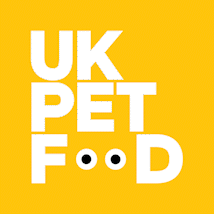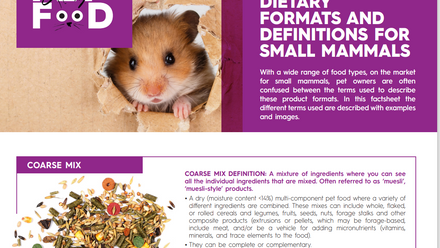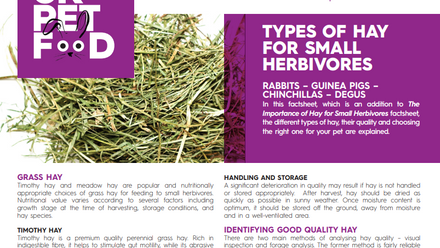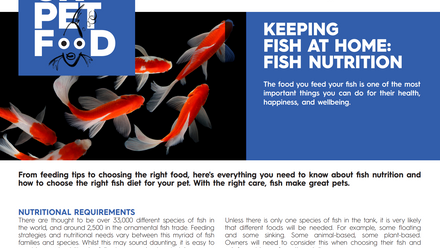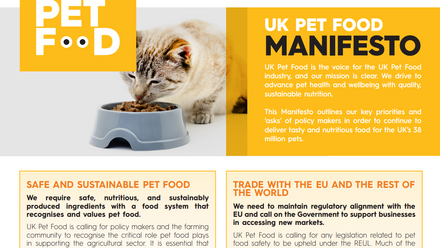Carbohydrates in Dog and Cat Food
‘Carbs’, ‘sugar’, ‘starch’ and ‘fibre’ are some of the terms often used when people talk about pet food and human food. But do we know what these terms mean and what do they cover?
‘Carbohydrates’ or ‘Carbs’ are in fact a category name for a group of macro-nutrients present in the diet of animals. People often use the terms ‘Carbohydrates’ or ‘Carbs’ when they are probably referring to starches! This is not a correct use of the term because starches are only one type of carbohydrates.
Depending on their size and function, carbohydrates can be sugars, starches or dietary fibre. Here you can find out about the role of these nutrients in the body of animals, how they are digested to produce energy and how they are labelled on pet food products.
Carbohydrates are important because they are the main source of energy as well as components of other molecules like DNA.
Structure of carbohydrates
Sugars
Monosaccharides: Glucose is the most important fuel (source of energy) in animal cells but it is rarely available in nature. When enzymes break down the larger macro-nutrients in the body, glucose becomes available. Its small size and character allows it to pass through the cell membrane and release energy when metabolised. Other examples of monosaccharides include fructose (also known as fruit sugar) and galactose (a component of the disaccharide, lactose, also known as milk sugar).
• Disaccharides: Most available sugars found in nature are disaccharides. They are made of two monosaccharides that are joined together. Examples are sucrose, lactose and maltose. If a cat or a dog has reduced levels of the specific enzyme to break down disaccharides, they may show signs of sensitivity and intolerance towards food containing it1 .
Starches
Can dogs digest cooked starch?
How about cats?
Dietary Fibre
Dietary fibre is a general term for the edible parts of plants that are resistant to digestion. Like the human, cats and dogs lack enzymes to break down dietary fibre5. Dietary fibre has many health benefits for dogs and cats. There are different classifications of dietary fibre6, one of which is based on their solubility in water:
• Soluble fibre, which dissolves in water and is fermented in the colon has many benefits for cats and dogs. It keeps the digestive tract healthy by stimulating beneficial bacteria and increased viscosity. Soluble fibre can be found in different quantities in cereals, fruits and vegetables.
• Insoluble fibre, which does not dissolve in water, can be metabolically inert, but may also contain some prebiotic fibre
which ferments in the large intestine. Insoluble fibre absorbs water as it moves through the digestive system, providing bulking and easing defecation and improving faecal consistency. Insoluble fibre is not a source of energy for cats and dogs and therefore will not contribute to weight gain. That’s why it is used in specially formulated ‘light’ diets to provide satiety without contributing energy. Insoluble fibre can be found in high concentration in whole grains and fruit skin.
Sources of carbohydrates
Labelling of carbohydrates in pet food
According to the EU law, it is mandatory to declare quantity of certain nutrients on all pet food labels, but that depends on the species of animal. For cats and dogs the following nutrients must be declared under Analytical Constituents:
• Protein (or Crude Protein)
• Crude fibres
• Fat content (or Crude oils and fats)
• Crude ash (or Incinerated residue or Inorganic matter)
Crude fibre is a measure that is determined by laboratory testing and needs to be on the label. However, it is not an indication of the soluble or insoluble dietary fibre content of the product.
Although labelling of sugars, starch and dietary fibre is not mandatory, a simple formula will allow you to work out the total
carbohydrate. % Carbohydrate = 100 – (% protein + % fat + % moisture + % ash) In this formula, If % moisture is not listed on the label, assume it is 10%
References
1 Wills, J., and R. Harvey. “Diagnosis and management of food allergy and intolerance in dogs and cats.” Australian veterinary journal 71.10 (1994):322-326.
2 Axelsson, Erik, et al. “The genomic signature of dog domestication reveals adaptation to a starch-rich diet.” Nature 495.7441 (2013): 360-364.
3 Perry, George H., et al. “Diet and the evolution of human amylase gene copy number variation.” Nature genetics 39.10 (2007): 1256-1260.
4 De-Oliveira, L. D., et al. “Effects of six carbohydrate sources on diet digestibility and postprandial glucose and insulin responses in cats.” Journal of animal science 86.9 (2008): 2237-2246.
5 Please note some dietary fibre (whether soluble or insoluble) may be fermentable in the digestive tract and release small amounts of energy
